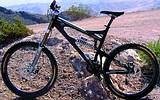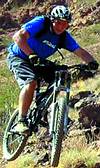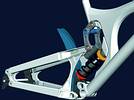Extreme confidence to build extreme bikes
December 2004

Santa Cruz Bicycles creates radical bikes that are faster cross-country, faster downhill and faster to market.
And why? To a large extent because of the software design. "(Pro/ENGINEER) has allowed us to hone our design processes so we can bring a better product to market. We can go through so many iterations that we can spend more time enhancing the model of each bike, instead of releasing it to market early or building several expensive prototypes," says Joseph Graney, design engineer for Santa Cruz Bicycles.
Pro/ENGINEER is a 3D software design solution for the design, engineering and manufacturing industries. Represented in sub-Saharan Africa by Centurion-based productONE, the software developers PTC now provide PLM (product lifestyle management) software solutions to more than 35 000 clients worldwide.
Dayne Turbitt, MD of productONE, says mountain biking has evolved in the last few years from an exhilarating, cardiovascular workout into a hard-core sport.
Today the sport has grown into extreme free-style riding and jumping where élite athletes fly over mountainous terrain on bicycles with knobby tyres. "The industry calls them free riders. At Santa Cruz Bicycles, they are called customers," Turbitt quips.
Santa Cruz Bicycles supplies high-end mountain bikes to serious riders for cross-country and free riding, as well as downhill racing. The company recently introduced three new bikes - the Blur for cross-country, the V10 downhill racer, and VP-Free, which is a cross between the two. Each of these bikes is built on a new suspension technology that is expected to define the next generation of off-road bikes.

A new generation suspension
Several years ago, Santa Cruz Bicycles acquired a series of patents for the Virtual Pivot Point (VPP) suspension. This is the most sophisticated suspension system in the bicycle industry - and it is the most complicated to implement.
A VPP bike, according to Graney, is a multipivot, four-bar linkage frame. Many of today's leading mountain bikes employ a multipivot point design, which means they are full-suspension, linkage frames that allow the rear wheel to travel a few inches as the rear frame absorbs impact - but Santa Cruz Bicycles' VPP bikes are different.
"Our VPP bikes are unique in the bike industry," Graney points out. "The two links that attach to the rear triangle counter-rotate, or fight each other. This allowed us to create a greater travel path for the rear wheel - over four inches for our cross-country bike and 10 inches for our downhill racer. It also gave us a number of different trajectories that we just could not get with a standard linkage. The challenge with the VPP technology was finding the optimum pivot location for each type of bike. Typically, this required hundreds and hundreds of calculations and we knew if we wanted to get these new bikes to market quickly, we needed the right tools. That is why we chose PTC."

Building a new bike
Santa Cruz Bicycles selected PTC's Pro/ENGINEER with behavioural modelling extension (BMX) to determine the best way to implement the Virtual Pivot Point technology into the product line and model the bikes. They also chose Pro/MECHANICA to test the models.
The software helped the company streamline its development and design cycles. Design engineers used BMX to create the skeleton of each bike, which includes establishing pivot point locations, pivot hard flanks, and the frame's top tube and down tube. Once the skeletons were complete, they used the solid modelling capability of Pro/ENGINEER.
Streamlining design processes
In the early stages of modelling, Santa Cruz Bicycles ran between 500 and 1000 different pivot locations for the Blur cross-country bike alone. Pro/ENGINEER ran each calculation in 5 to 10 minutes, where the hand calculations had been taking over 90 minutes to perform.
"Pro/ENGINEER helped us accelerate the development of our VPP bikes," adds Graney. "It has also allowed us to hone our design processes so we can bring a better product to market. We can go through so many iterations that we can spend more time enhancing the model of each bike, instead of releasing it to market early or building several expensive prototypes."
Lighter and stronger
Another major challenge in designing a high-end bike is to make it as light as possible. To achieve this, the design engineers at Santa Cruz Bicycles used Pro/MECHANICA to strip material out of the bikes. One way they saved weight was to design each tube of the bike's frame with a different wall thickness on each end and thinner walls down through the middle section.
"You can spend a lot of money in the manufacturing process just to take weight out," says Blur design engineer, David Earle. "Pro/MECHANICA helps determine where that weight can come from without sacrificing the bike's strength, durability, or stiffness. We can calculate exactly what the stress might be at a certain point before we physically build it and test it."
Test the model
Unlike some larger bicycle companies, Santa Cruz Bicycles does not have an extensive testing facility for running fatigue-analysis on prototype bike frames. But Pro/MECHANICA gives the company the confidence that the prototype bike will live up to their expectations, because they have already fatigue tested the bikes to determine where problems might occur. When a prototype is ready, Santa Cruz Bicycles invites some of the country's best hard-core riders to break it.
"Pro/ENGINEER and Pro/MECHANICA help us test ideas during the design phase," says Graney. "For example, a tremendous amount of force runs through the shock absorber on our V10 downhill racing bike. Travelling at 80 km an hour straight down a 70-degree slope will exert several thousand pounds of force from the shock onto the shock mounts that are on the down tube. The down tube area has very thin walls where the shock mounts are, so we model that area in Pro/MECHANICA and apply the force variables to accurately determine what the stress is on the tube and where we are under yield. With this software, we can move the shock tabs around and try different shapes and lengths. Pro/MECHANICA gives us accurate answers rapidly without having to physically build and test each configuration."
Delivering a better bike
Santa Cruz Bicycles has the confidence that the bikes they bring to market are among the very best in the industry. Pro/ENGINEER and Pro/MECHANICA have helped them streamline their development and design cycles, eliminate the need to build a large number of expensive prototypes, and present designs to manufacturing that have been fully tested to ensure full quality assurance. "Pro/ENGINEER and Pro/MECHANICA are not only helping us get the VPP line to market faster," agree Graney and Earle. "They are allowing us to bring a better product to market. Ultimately, this is what makes our riders happy."
For more information contact Dayne Turbitt, productONE, 012 673 9300.
Others who read this also read these articles
The high-end MCAD and cPDm market segments of the PLM strategy
CIMdata considers the high-end MCAD market to include only those few CAD solution providers that deliver very comprehensive computer-aided design and analysis capabilities that are also tightly integrated with an enterprise-capable cPDm solution from the same supplier[ December 2005 ]
SA's prototype designers awarded
The SABS Design Institute is the driving force behind design promotion in the country through various award schemes, supporting innovation and entrepreneurship[ October 2005 ]
2D to 3D: the path to better products, faster and cheaper
Modern 3D CAD systems allow designers and engineers to edit a few parameters and automatically create the downstream deliverables for unique variants in minutes, instead of days or weeks[ October 2005 ]
ECL in Africa
ECL ensures a worldwide coverage of its client base through local service units which incorporate all the ECL know-how[ August 2005 ]
Catia brings business to South Africa
The fact that the A400M contracts were awarded to local enterprises is a strategic breakthrough for the South African aerospace industry[ August 2005 ]
Strand7 analyses the Beijing Water Cube
The latest Strand7 Release 2.3 has added the capability to take site specific seismic time histories and simply create equivalent spectral curves[ June 2005 ]
Pro/E versus SolidWorks
In summary, SolidWorks' swept surfaces and solids are more limited in their capabilities than Pro/Engineer's[ June 2005 ]
Northern Railway Extension receives green light
Windhoek Consulting Engineers was appointed as consulting engineers for the Northern Railway Extension, responsible for all aspects regarding the design and construction supervision of the total project valued at N$ 1,4 billion[ April 2005 ]
Others who read this also read these news items
Digitising a standard racing engine provides a springboard for future improvements
[ December 2005 ]
Nelson Mandela Metropolitan University leads the way with Catia V5
[ December 2005 ]
Integrated CNC solution for SA tooling industry
[ December 2005 ]
Accelerated design at Donkin Fans
[ December 2005 ]
PGF transforms its vision into reality
[ December 2005 ]
Defy introduces new product range
[ October 2005 ]
New Smarts for legal eagles
[ October 2005, Cadshop ]
Vectorworks scores with architects on ease of use
[ October 2005 ]
Others who read this also read these regulars
Search Site
Subscribe
Previous Issues
Other Technews Publications
Other Technews Buyers Guides
 |  | Copyright c1995-2009 Technews Publishing (Pty) Ltd.. All rights reserved. |